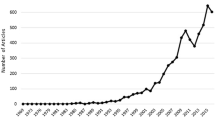Abstract
While a relationship in a social or business network should be mutually beneficial, it is ambiguous whether the relationship benefits or harms the rest of the network. This paper focuses on the situation where any new relationship imposes a negative externality on the rest of the network. We model this by assuming an agent’s payoff from a relationship is a decreasing function of the number of relationships the other agent maintains. We solve for the socially efficient and stable networks. While in general the two diverge, we demonstrate that they coincide when agents are able to make transfers to their partners.
Similar content being viewed by others
References
Bala V, Goyal S (2000) A non-cooperative model of network formation. Econometrica 68: 1181–1230
Bloch F, Jackson M (2007) The formation of networks with transfers among players. J Econ Theory 133: 83–110
Bramoulle J, Kranton R (2007) Risk-sharing networks. J Econ Behav Organ 64: 275–294
Calvo-Armengol T, Jackson M (2004) The effects of social networks on employment and inequality. Am Econ Rev 94: 426–454
Currarini S (2007) Network design in games with spillovers. Rev Econ Des 10(4): 305–326
Dutta B, Jackson MO (2000) The stability and efficiency of directed communication networks. Rev Econ Des 5: 251–272
Goyal S, Joshi S (2006) Unequal connections. Int J Game Theory 34: 319–349
Goyal S, Vega-Redondo F (2004) Structural holes in social networks. J Econ Theory 137: 460–492
Hojman D, Szeidl A (2008) Core and periphery in networks. J Econ Theory 139: 295–309
Ioannides YM, Loury LD (2004) Job information networks, neighborhood effects and inequality. J Econ Lit 42(4): 1056–1093
Jackson MO (2004) A survey of models of network formation: stability and efficiency. In: Demange G, Wooders M (eds) Group formation in economics; networks, clubs and coalitions. Cambridge University Press, Cambridge
Jackson MO (2008) Social and economic networks. Princeton University Press, Princeton, NJ
Jackson MO, Wolinsky A (1996) A strategic model of social and economic networks. J Econ Theory 71: 44–74
Kranton R, Minehart D (2001) A theory of buyer–seller networks. Am Econ Rev 91: 485–508
Matsubayashi N, Yamakawa S (2006) A note on network formation with decay. Econ Lett 93(3): 387–392
Watts A (2001) A dynamic model of network formation. Games Econ Behav 34: 331–341
Author information
Authors and Affiliations
Corresponding author
Rights and permissions
About this article
Cite this article
Morrill, T. Network formation under negative degree-based externalities. Int J Game Theory 40, 367–385 (2011). https://doi.org/10.1007/s00182-010-0256-4
Published:
Issue Date:
DOI: https://doi.org/10.1007/s00182-010-0256-4




